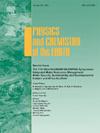铬铁矿矿床评价:巴基斯坦北部Kohistan岛弧的磁学和地球化学综合研究
IF 3
3区 地球科学
Q2 GEOSCIENCES, MULTIDISCIPLINARY
引用次数: 0
摘要
在巴基斯坦北部和西部的蛇绿岩带中发现了大量铬铁矿。研究了铬铁矿的磁性响应及其伴生矿物的富集情况。225个观测站的测量结果显示了显著的磁异常,峰值为4155.34 nT(剖面A)、3607 nT(剖面B)、3450.3 nT(剖面C)、2247.02 nT(剖面D)和5146.35 nT(剖面E)。53个岩石样品的地球化学分析显示,铬(324 mg/kg)、铁(30660 mg/kg)、镍(114000 mg/kg)、钴(263.8 mg/kg)、铜(147.34 mg/kg)和铅(376.4 mg/kg)的浓度较高。铁、铬、镍、钴、铜和铅的最高浓度是在不同剖面的特定样品中发现的。主成分分析表明,铁、镍、锰和砷有一个共同的来源,表明一个标准的矿体可能包括赤铁矿、磁铁矿、雄黄或镍黄铁矿。这些发现突出了一个复杂的多矿化矿体,具有巨大的经济潜力。巴基斯坦的铬铁矿和相关矿床,特别是镍和钴矿床,对可再生能源技术至关重要,并提供了大规模采矿机会。这项研究强调有必要系统地勘探巴基斯坦的矿物资源,以加强其在全球矿物市场上的作用。本文章由计算机程序翻译,如有差异,请以英文原文为准。

Evaluating chromite ore deposits: An integrated magnetic and geochemical study in the Kohistan Island Arc of northern Pakistan
Extensive chromite deposits have been documented and extracted from the ophiolitic belts in northern and western Pakistan. This research investigates chromite ore's magnetic response and associated mineral's concentrations. Measurements from 225 observation stations revealed significant magnetic anomalies, with peak values of 4155.34 nT (Profile A), 3607 nT (Profile B), 3450.3 nT (Profile C), 2247.02 nT (Profile D), and 5146.35 nT (Profile E). Geochemical analysis of fifty-three rock samples showed high concentrations of chromium (324 mg/kg), iron (30,660 mg/kg), nickel (114,000 mg/kg), cobalt (263.8 mg/kg), copper (147.34 mg/kg), and lead (376.4 mg/kg). The highest concentrations of iron, chromium, nickel, cobalt, copper, and lead were found in specific samples within different profiles. Principal Component Analysis suggests that iron, nickel, manganese, and arsenic share a common origin, indicating a standard ore body that may include hematite, magnetite, realgar, or pentlandite. These findings highlight a complex, multi-mineralized ore body with significant economic potential. Pakistan's chromite and associated deposits, especially in nickel and cobalt, are crucial for renewable energy technologies and present large-scale mining opportunities. This study emphasizes the need to systematically explore Pakistan's mineral resources to enhance its role in the global mineral market.
求助全文
通过发布文献求助,成功后即可免费获取论文全文。
去求助
来源期刊

Physics and Chemistry of the Earth
地学-地球科学综合
CiteScore
5.40
自引率
2.70%
发文量
176
审稿时长
31.6 weeks
期刊介绍:
Physics and Chemistry of the Earth is an international interdisciplinary journal for the rapid publication of collections of refereed communications in separate thematic issues, either stemming from scientific meetings, or, especially compiled for the occasion. There is no restriction on the length of articles published in the journal. Physics and Chemistry of the Earth incorporates the separate Parts A, B and C which existed until the end of 2001.
Please note: the Editors are unable to consider submissions that are not invited or linked to a thematic issue. Please do not submit unsolicited papers.
The journal covers the following subject areas:
-Solid Earth and Geodesy:
(geology, geochemistry, tectonophysics, seismology, volcanology, palaeomagnetism and rock magnetism, electromagnetism and potential fields, marine and environmental geosciences as well as geodesy).
-Hydrology, Oceans and Atmosphere:
(hydrology and water resources research, engineering and management, oceanography and oceanic chemistry, shelf, sea, lake and river sciences, meteorology and atmospheric sciences incl. chemistry as well as climatology and glaciology).
-Solar-Terrestrial and Planetary Science:
(solar, heliospheric and solar-planetary sciences, geology, geophysics and atmospheric sciences of planets, satellites and small bodies as well as cosmochemistry and exobiology).
 求助内容:
求助内容: 应助结果提醒方式:
应助结果提醒方式:


